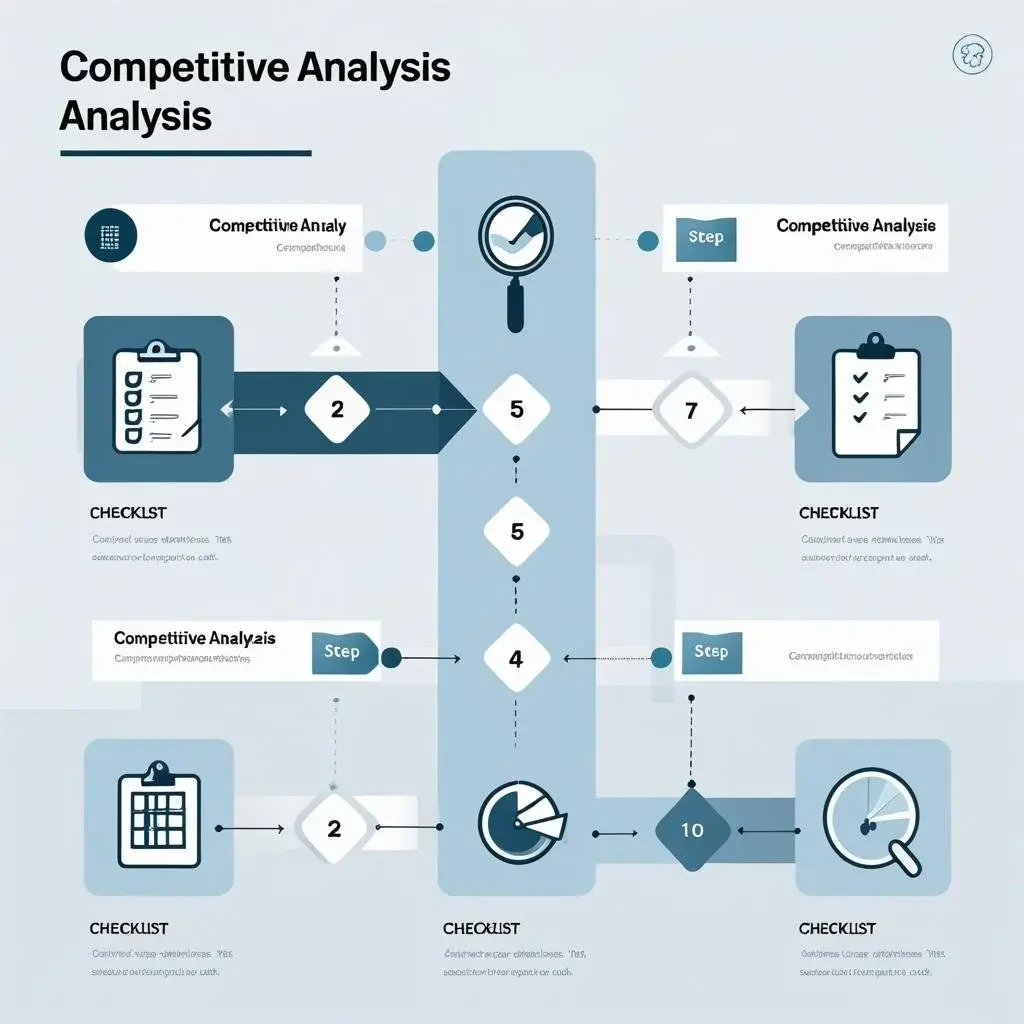Mastering Competitive Analysis: A Guide for Business Success
.webp)
What is Competitive Analysis and Why Does It Matter?

Competitive analysis involves identifying your competitors—both direct and indirect—and evaluating their products, services, marketing tactics, and market position. By doing so, you can uncover opportunities to differentiate your business and make informed decisions. Research suggests it’s a critical tool for understanding market trends, benchmarking performance, and spotting untapped opportunities. But what do you think makes this process so valuable in today’s fast-paced business world?
Key Benefits to Explore
- Market Insight: How might understanding your competitors’ strategies help you better understand your customers’ needs?
- Strategic Advantage: Could knowing what your competitors do well (or poorly) shape your own business decisions?
- Opportunity Identification: What opportunities might you find by studying where your competitors fall short?
Things to Keep in Mind
Competitive analysis isn’t about copying your rivals or undercutting their prices. It’s about learning from their successes and failures to carve out your own unique path. It’s also not a one-time task—markets evolve, so regular analysis is key. How often do you think a business should revisit its competitive analysis to stay relevant?
Winner
SalesForce, for its ability to handle large-scale operations and complex business needs, though HubSpot is scalable for SMBs.
A Deep Dive into Competitive Analysis: Your Path to Strategic Success

Let’s explore competitive analysis in depth, as if we’re building a roadmap together. What questions would you ask if you were trying to understand your competitors? Let’s walk through the process step by step, asking questions to spark curiosity and guide your thinking.
What Exactly is Competitive Analysis?
Imagine you’re a coach preparing for a big game. You’d study the opposing team’s playbook, right? Competitive analysis is similar—it’s about studying your competitors to understand their game plan. It involves identifying who your competitors are, analyzing their products, services, marketing strategies, and market position, and then comparing them to your own business. Why do you think this comparison is so crucial for making smart business decisions?
According to industry experts, competitive analysis helps you:
- Understand the Market: Gain insights into customer preferences and market trends.
- Learn from Others: Identify what strategies work (or don’t) without reinventing the wheel.
- Position Your Brand: Find ways to differentiate your business and appeal to your target audience.
But what does “understanding the market” mean to you? Could it involve looking at customer reviews, pricing strategies, or something else entirely?
Why Should You Conduct a Competitive Analysis?
Let’s reflect: why might a business need to know what its competitors are doing? In a crowded marketplace, understanding your competition can be the difference between thriving and merely surviving. Here are some reasons to consider:
- Strategic Planning: How could knowing your competitors’ marketing tactics help you craft a better campaign?
- Benchmarking: What would it mean to measure your performance against industry leaders?
- Opportunity Spotting: Can you think of a time when a business missed an opportunity because it didn’t understand its competitors?
Research from sources like HubSpot and Asana suggests that competitive analysis is a high-ROI activity that helps businesses stay agile and responsive. It’s not just about keeping up—it’s about finding ways to stand out. What do you think is the biggest benefit for a business like yours?
Step-by-Step Guide to Conducting a Competitive Analysis

Step 1: Create a Competitor Overview
Who are your competitors? Start by identifying 5-10 key players in your market. Direct competitors offer similar products or services to the same audience, while indirect competitors might target the same audience with different offerings. For example, if you run a coffee shop, your direct competitors are other coffee shops, but indirect competitors could include tea houses or juice bars.
- How to do it: Use Google or Amazon to search for your product or service. Check review sites like Trustpilot or G2, or ask your customers who else they considered.
- Question to ponder: Are there any emerging competitors in your industry that might disrupt the market?
Step 2: Conduct Market Research
What do you know about your competitors’ operations? This step involves gathering detailed information about their products, pricing, marketing strategies, and customer service. You can use:
- Primary research: Buy their products, read customer reviews, or conduct surveys.
- Secondary research: Analyze their websites, social media, or press releases.
Tools like Ahrefs or SEMrush can provide insights into their SEO performance and website traffic. Why do you think understanding their online presence is so important?
Step 3: Compare Product Features
How does your product or service compare to your competitors’? Create a feature-by-feature comparison, focusing on aspects like price, quality, design, ease of use, and customer support. For instance, if you’re selling software, compare features, pricing tiers, and user experience.
- Tip: Use a spreadsheet or comparison chart to keep things organized.
- Question to consider: What feature of your product could you highlight to stand out?
Step 4: Compare Product Marketing
What story are your competitors telling? Analyze their marketing efforts—social media posts, website copy, paid ads, and brand messaging. Are they focusing on price, quality, or customer experience? Understanding their target audience and brand voice can inspire your own marketing strategy.
- How to do it: Follow their social media accounts, review their website, and note their advertising campaigns.
- Question to explore: How could you adapt a competitor’s successful marketing tactic to fit your brand?
Step 5: Use a SWOT Analysis
What are your competitors’ strengths and weaknesses? A SWOT analysis (Strengths, Weaknesses, Opportunities, Threats) is a powerful tool to structure your findings. For each competitor and your own business, ask:
- Strengths: What do they do well?
- Weaknesses: Where are they falling short?
- Opportunities: What market gaps can you fill?
- Threats: What external factors could impact your business?
Tools like Miro or Asana’s SWOT templates can help visualize this. Why do you think a structured approach like SWOT is so effective?
Step 6: Identify Your Place in the Market Landscape
Where do you stand in the market? Create a visual representation, such as a graph with axes for customer satisfaction and market presence. Plot your competitors and your business to see where you excel or lag behind.
- How to do it: Use data from your research to plot points on a graph.
- Question to reflect on: What would it take to move your business into a leadership position on this graph?
Real-World Examples

Let’s make this practical. How might different roles use competitive analysis? Here are three scenarios:
- Marketing Specialists: They might analyze competitors’ SEO strategies, social media engagement, and content marketing. A SWOT analysis can help them identify gaps in their own campaigns. For example, if a competitor’s blog drives traffic, could you create similar content with a unique spin?
- SME Business Development Managers: They focus on client testimonials, service offerings, and pricing models. A comparison chart can show how their services compare, helping them pitch more effectively.
- Product Managers: They compare product features, user experience, and technological advancements. A detailed report can guide decisions about new features or improvements.
What role in your business could benefit most from competitive analysis, and why?
Tools and Templates to Streamline the Process

What tools could make this process easier? Here are some options:
- Research Tools:
- Ahrefs or SEMrush: For SEO and website traffic analysis.
- SimilarWeb or Google Trends: For market and competitor insights.
- Visualization Tools:
- Miro: For collaborative SWOT analyses.
- Venngage: Offers templates for SWOT analyses, comparison charts, and reports.
- Templates:
- Venngage’s SWOT Analysis Template for marketing teams.
- Comparison Chart Template for business development.
How to Use Your Findingss

Once you’ve completed your analysis, what’s next? The insights you gain are only valuable if you act on them. Consider:
- Refining Strategies: Could you adjust your marketing or product offerings based on what you’ve learned?
- Setting Goals: What specific goals could you set to improve your market position?
- Monitoring Progress: How often should you check back to see if your strategies are working?
For example, if you discover a competitor’s pricing is lower, could you offer more value instead of cutting prices? Or if their social media engagement is strong, what could you learn from their approach?
Wrapping Up
Founder & CEO @ Hubxpert. My goal is to make every company using HubSpot succeed in their marketing organisation and automation.

Ratul Rahman
Table of Contents:
Subscribe to our newsletter

HubSpot: Elevating Bangladeshi Consultancies Beyond Excel
Our 2024 Beginner's Guide to Revenue Attribution Models explains key models & helps you choose the right one to optimize campaigns & boost ROI.

Why Bangladeshi Consultancies Lose 30% of Leads—and How to Fix It
Our 2024 Beginner's Guide to Revenue Attribution Models explains key models & helps you choose the right one to optimize campaigns & boost ROI.

Bangladeshi Study-Abroad Marketing: Converting Social Media into Leads
Our 2024 Beginner's Guide to Revenue Attribution Models explains key models & helps you choose the right one to optimize campaigns & boost ROI.

Best CRM for Education Businesses in Bangladesh
Our 2024 Beginner's Guide to Revenue Attribution Models explains key models & helps you choose the right one to optimize campaigns & boost ROI.

Modern Sales Systems That Actually Convert for Bangladeshi Consultancies
Our 2024 Beginner's Guide to Revenue Attribution Models explains key models & helps you choose the right one to optimize campaigns & boost ROI.

What I Learned Helping Healthcare Businesses Fix Their Sales & Marketing Process
Discover how connected CRM systems like HubSpot can transform healthcare sales and marketing processes, improving patient engagement, reducing no-shows, and streamlining workflows.
-

HubSpot: Elevating Bangladeshi Consultancies Beyond Excel
Discover how businesses are using HubSpot to streamline marketing efforts, boost lead generation, and drive sustainable growth through data-driven strategies.
Marketing -

Why Bangladeshi Consultancies Lose 30% of Leads—and How to Fix It
Discover how businesses are using HubSpot to streamline marketing efforts, boost lead generation, and drive sustainable growth through data-driven strategies.
Marketing -

Bangladeshi Study-Abroad Marketing: Converting Social Media into Leads
Discover how businesses are using HubSpot to streamline marketing efforts, boost lead generation, and drive sustainable growth through data-driven strategies.
Marketing -

Best CRM for Education Businesses in Bangladesh
Discover how businesses are using HubSpot to streamline marketing efforts, boost lead generation, and drive sustainable growth through data-driven strategies.
Marketing -

Modern Sales Systems That Actually Convert for Bangladeshi Consultancies
Discover how businesses are using HubSpot to streamline marketing efforts, boost lead generation, and drive sustainable growth through data-driven strategies.
Marketing -

What I Learned Helping Healthcare Businesses Fix Their Sales & Marketing Process
Discover how businesses are using HubSpot to streamline marketing efforts, boost lead generation, and drive sustainable growth through data-driven strategies.
General




